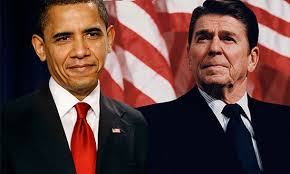From Then to Now: A Retrospective of the American Economy
February 6, 2015
President Obama’s State of the Union received right wing criticism instantaneously. Both Joni Ernst and Ted Cruz came out and spoke against the President plan to give tax cuts to the middle class and tax increases on the wealthiest Americans. Ted Cruz claims that Obama’s policies have failed the past six years, and that Obama wants to continue these failing policies. Now, to give Cruz credit, Obama’s last two terms have not been as successful as anyone had hoped for. Then again, Ted Cruz is a supporter of Reagan style economics which have devastated the American economy. This may be contrary to popular belief but through inspection, one could easily see the failure of trickle down economics.
During Reagan’s tenure as president, corporate profits soared. This is a good thing, but there are many other factors to the success of an economy other than corporate profits. During Reagan’s administration, wages stagnated (wages are still stagnant to this day). Despite the doubling of the economy from 1980-1990 and the increase in corporate revenue, workers saw nothing in return. With the minimum wage actually lower than 1968 levels when adjusted to inflation and the increase of money flowing to the top, consumption of the middle class decreased. After all, how does anyone expect consumption to increase when wages are flat and money is concentrated in the top income earners’ bank accounts? The richest Americans spent no where near as great a proportion of their incomes as the lower and middle classes do. With the middle class seeing little to no economic benefits but still seeking to increase their standard of living, they borrowed money. This middle class microloan trend continued up until the crash of 2008 (a contributing factor). When the banks failed, they were bailed out. The richest came out just as wealthy or even wealthier than before. On the other hand, the common man felt nothing but the effects of economic devastation.
Cruz supports tax cuts which despite conservative beliefs, do not increase employment or economic prosperity. There is no correlation between economic prosperity and tax cuts. None. Yet he and the majority of conservatives support this policy. Before Reagan, the highest marginal tax rate was 70%. After Reagan, it was 35%. The result is a decrease in tax revenue, less public spending, and increased income inequality. They also feel it is necessary to cut public spending. Public spending has had great benefits for the economy, especially in fields of science and technology. Public spending is often criticized, but many do not realize that the national debt after World War II was 120% of the GDP. This was not entirely negative, as it led to economic prosperity for years to come. The efficacy of deficit spending depends on where the money is being allocated; the outcome could be fantastic or destructive. For example, President Bush’s funding of the wars in the Middle East profited no one, whereas during the Great Depression, FDR’s use of national debt contributed to programs that would support the economy in the future, such as education, health care, technology and encouragement of private investment.
Let’s look at the alternatives to Cruz’s plan. Redistribution for the sake of redistribution is ineffective, as seen in Europe. But this is not what is being proposed. The proposition on the table is to return the economy back to the way it was during the post World War II years, when public spending was not seen as a menace and when the highest tax rates never fell below 77% (even reaching a high 90% during the administration of Republican president Eisenhower). If tax cuts and and a decrease in public spending are such a great thing, then its difficult to explain why the economy from 1980 to present day is doing much worse than it was from 1950-1970. By giving tax breaks to the wealthiest Americans, cutting safety nets and public spending, and not increasing the minimum wage, the only effect will be a lack of consumer spending, continued stagnant wages, a loss in corporate revenue, and higher inequality. Currently inequality is at basically the same levels it was at in 1928, before the economy collapsed into the Great Depression. The president is not proposing bleeding heart policies doomed to failure; he is putting forth an economic policy that will lift the American economy back up on its feet, back to the way it was during the post-World War II era.


